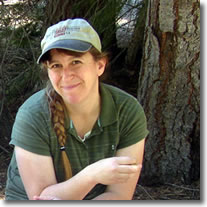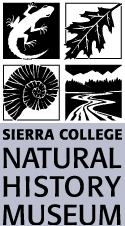Welcome to the Journal of the Sierra College Natural History Museum
Keely Carroll, Executive Editor
 I have a fairly long commute. I drive it 5 days a week and it takes me nearly an hour each way. While I can’t speak for everyone else, I can say that I don’t spend that time admiring or really even paying attention to the scenery along the way. I switch on NPR and my brain goes into autopilot mode, faithfully taking me to Sierra College every day. This past semester I had to take my 7-year-old daughter with me to work, and while I skipped the NPR that day in exchange for a conversation about WebKinz, I still didn’t pay much attention to my commute. Now, perhaps because she was new to the drive or perhaps because she is a child, she pointed out some young foals that were in a field along our route up Hazel Boulevard. While those foals looked to be a few months old, I have never noticed them or any other horses for that matter in that pasture before. Why had I never taken the time to notice them before? I had done this drive many times and I should have at least noticed them before.
I have a fairly long commute. I drive it 5 days a week and it takes me nearly an hour each way. While I can’t speak for everyone else, I can say that I don’t spend that time admiring or really even paying attention to the scenery along the way. I switch on NPR and my brain goes into autopilot mode, faithfully taking me to Sierra College every day. This past semester I had to take my 7-year-old daughter with me to work, and while I skipped the NPR that day in exchange for a conversation about WebKinz, I still didn’t pay much attention to my commute. Now, perhaps because she was new to the drive or perhaps because she is a child, she pointed out some young foals that were in a field along our route up Hazel Boulevard. While those foals looked to be a few months old, I have never noticed them or any other horses for that matter in that pasture before. Why had I never taken the time to notice them before? I had done this drive many times and I should have at least noticed them before.
Sacramento is a pretty remarkable place. I have never been to another California city quite like it. You can drive through the heart of the city and still see agricultural land or, as mentioned above, livestock. Our city is steeped in history. How many Sacramentans grew up taking field trips to Sutter’s Fort or to Coloma to see the Gold Rush site? We don’t think about these areas as being that special because we have always had them in our backyard yet people travel hundreds and even thousands of miles to see them every year.
Interstate 80 Corridor
One of our more overlooked historical and ecological treasures is the Interstate 80 corridor. I know, it sounds strange, but bear with me. Constructed during the 1960s, this interstate connected Sacramento to Nevada and points east, as well as, to the Bay Area. In this edition of the ejournal we celebrate this oft unappreciated roadway with a series of articles devoted to its Natural History. To really help you to experience the majesty (yes, I said majesty) of this corridor we have three photo journals in this edition. The first is a photo journal of the construction of Interstate 80 which was complied by Gary Noy. The second illustrates the diversity of habitats that one can experience as you travel the corridor in a collection of photos taken by Joe Medeiros. The third contains photos taken from our own nature area here on the Sierra College campus, taken by Jim Wilson.
The text articles in this edition each take a view of a different aspect of this area. We have an article summarizing the climatic conditions at Donner Summit by Randall Osterhuber. The climatic conditions of this region are of particular importance to the rest of California as the majority of our water supply comes from the snowmelt of this region. A related article by Mark McLaughlin on the weather along Donner Pass entitled “Reign of the Sierra Storm King: Weather History of Donner Pass” summarizes the effects of storms in this region on people who have traversed the corridor. From the Donner Party to the stranding of the City of San Francisco luxury steamliner, many have found themselves trapped in a Sierra snowstorm.
Geology and Ecology
The next article that we have contains a summary of the geology of the corridor by Dick Hilton. This article contains information listed out as a series of stops along the corridor that you can check out next time you pass by the area. Not to be left out, we have an article on the ecology of the Interstate 80 corridor by Joe Medeiros. Many of us know that the vegetation changes as we move up the slope but few of us know why. This article explains those changes and discusses each of the environments along the way.
Finally, we continue our efforts to highlight the many great resources of the Sierra College campus with an article on the campus arboreta by Sierra College biologist Shawna Martinez. West Arboreta feature displays of native trees and plants found along Interstate 80 including plants typical of cooler and higher climate zones. It includes a vernal pool that is home to plant life unique to these temporary environments. East Arboreta features specimen trees from other parts of the country and the world that are important to foresters and landscapers. The Sierra College Arboreta are valuable teaching aids for students of all ages.
It is my hope that the information contained within this edition will help you to better appreciate your next journey along the interstate 80 corridor and that it won’t take a 7-year-old to remind you that it is not always about the destination but the journey that is important as well.
Once again I would like to thank Gary Noy who is always instrumental in putting together these ejournal editions and Mike Price who formats and publishes the editions to the web. As always I welcome your thoughts, comments and any submissions to the journal at kcarroll@sierracollege.edu.
Keely Carroll
